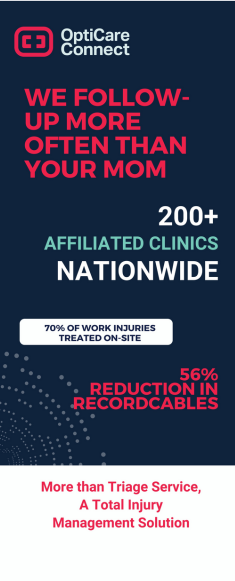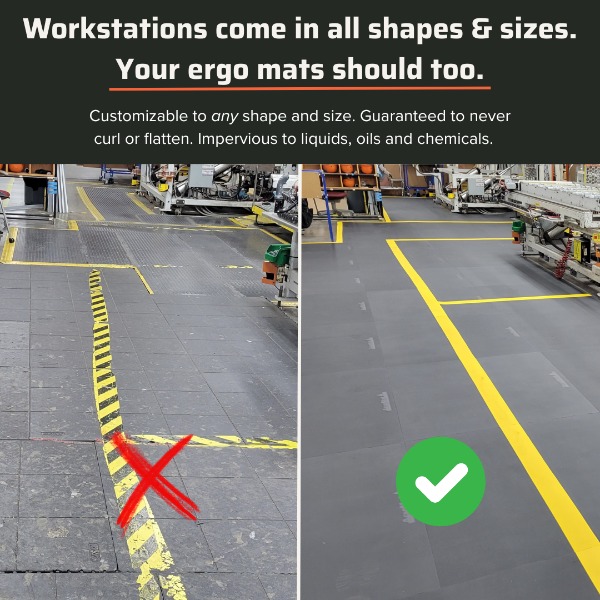The community for Health and Safety Professionals. Check out today's discussions.

 Welcome to Safety Knights!
Welcome to Safety Knights! The community for Health and Safety Professionals. Check out today's discussions.

Safety Knights Grand Re-Opening
Big news—our Grand Re‑Opening is live, and we’ve teamed up with Work Zone Coffee Company to fuel your safety hustle! With every click, post, and quiz on Safety Knights, you’re racking up points that can score you cash—and a fresh cup of premium coffee that stands for something more. Here’s how to earn points and start winning: ✏️25 points just for signing up 😃10 points for completing your profile 🎫10 points for RSVPing to The People’s Safety Summit - https://safetyknights.com/event/685d5fd4619587cf0dc724ab/the_people_s_safety_summit 👫5 Points Each for Inviting People that Register to Safety Knights 📲5 points per post (share your EHS insights, introductions—anything you’re already posting on LinkedIn!) 📸5 points for uploading a profile picture 📝3 points for taking quizzes 💬1 point for every like or comment We bet you get this done in under 10 mins. What’s up for grabs? 🏆Weekly Champion: $50 Visa gift card + a free Work Zone Coffee sample 🎫Weekly Raffle: 1 of 3 $25 Visa gift cards + a free Work Zone Coffee sample 🏅Grand Prize: Top scorer over two months wins $500 in cash + a free Work Zone Coffee sample Don’t just browse—engage, compete, and sip your way to big rewards. If you have an account with us already, just sign in and perform one of the actions we listed and you'll get your sign up points, plus the points for that action.
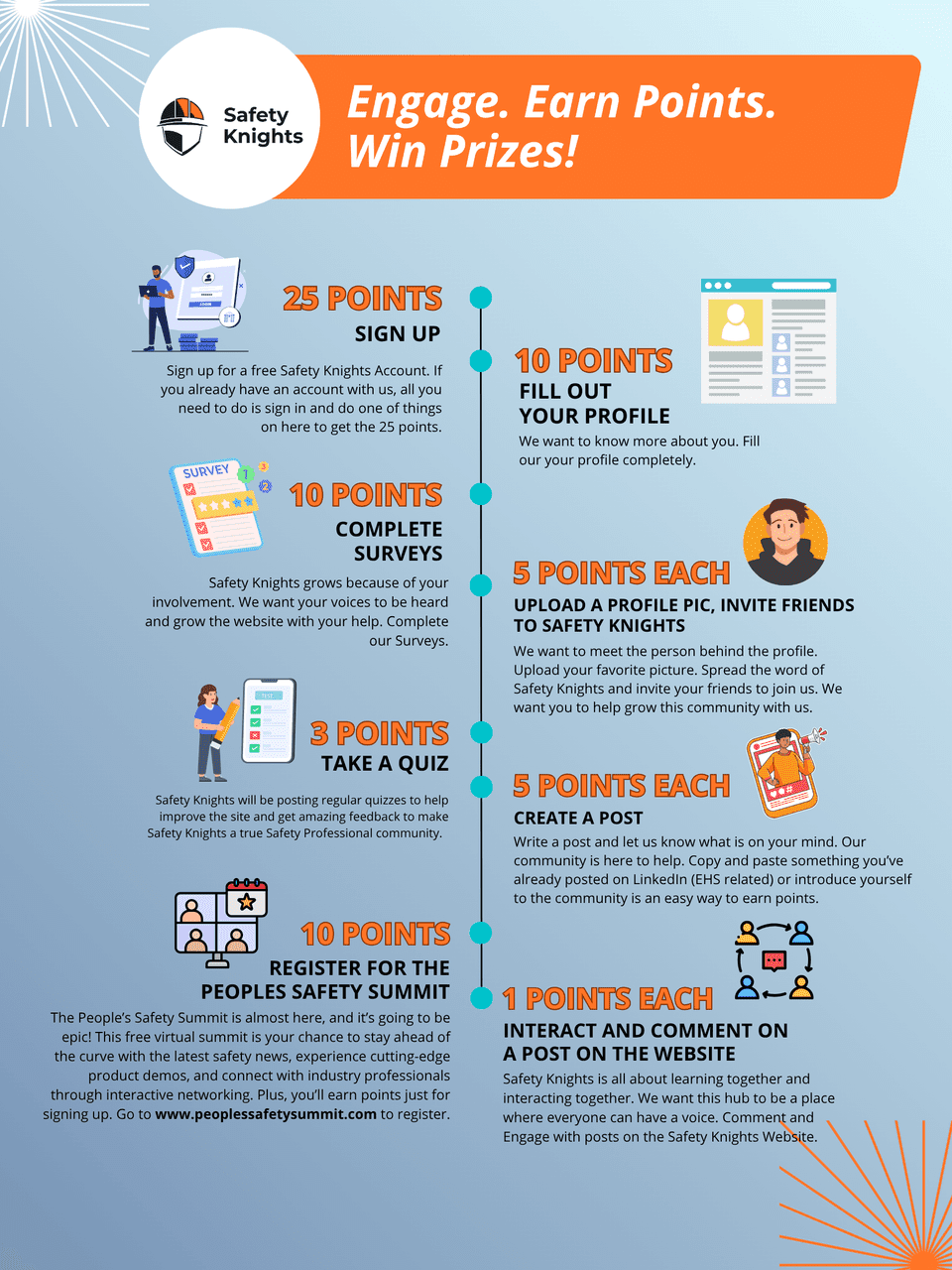

PSIF VS Near-miss program thoughts
Hi everyone I hope you all are safe! Thoughts on having pSIF programs vs. near-miss programs? I saw a post somewhere that stated they’re better and can help reduce injuries. I also did some light research that you can combine these two for optimal effectiveness. I’d love to hear from anyone with this experience.
Lift Table Skirts
Are lift table skirts required? I had an OSHA Inspector mention at another facility that they want to see them. I told that to our Maintenance person at another facility and he hit me with the "I googled it and there's no standard for it." and then hit me with the "train people not to put their hands there and we're fine" It was a terrific exchange.

Prescription Safety Glasses
I seem to recall a post at one time that dealt with Prescription Safety Glasses but cannot find it. My manager, our VP of Operation, surprised me by shooting out an email to all our management team that safety glasses usage was going to now be enforced. It's always been a policy in our shop and service trucks but never truly enforced. We had some locations and companies better than others at ensuring everyone was complying. Today, we were talking and he asked if we had a reimbursement program for prescription safety glasses. When I first started I was able to get approval for $75 reimbursement. That has been almost 10 years ago or more and we get very few who take advantage of it due to the low reimbursement value. He talked about getting with our owner and seeing if we can get it bumped up. So, I'm curious who all reimburses for prescription safety glasses and if you do, up to what amount do you reimburse and what frequency? Ours is also every two years unless they are damaged during the course of working.

Sodium-Ion vs Lithium-Ion Battery - Safety Comparison
Sodium-Ion vs Lithium-Ion Battery Safety Comparison Overview Sodium-Ion Batteries (Na-ion): Emerging alternative to lithium-ion; use sodium ions for charge transfer; abundant and low-cost. Sodium-Ion Statistics: Energy Density: 90–160 Wh/kg; Fire Hazard Severity: Moderate; Electrolyte Flammability: Yes; Thermal Runaway Temp: Slightly higher; Mitigation Strategies: BMS, thermal sensors, ceramic separators; SEI Breakdown Temp: 176 °F / 80 °C; Electrolyte Decomposition: 302 °F / 150 °C; Runaway Propagation Temp: 392 °F / 200 °C; Hazardous Off-Gas Produced: CO, HF, organics (moderate); Severity of Off-Gas: Moderate. Lithium-Ion Batteries (Li-ion): Industry standard; use lithium ions for charge transfer; higher energy density. Lithium-Ion Statistics: Energy Density: 150–250 Wh/kg; Fire Hazard Severity: High; Electrolyte Flammability: Yes; Thermal Runaway Temp: Lower; Mitigation Strategies: BMS, flame-retardant electrolyte, cooling systems; SEI Breakdown Temp: ~158–176 °F / ~70–80 °C; Electrolyte Decomposition: ~212–302 °F / ~100–150 °C; Runaway Propagation Temp: ~320–392 °F / ~160–200 °C; Hazardous Off-Gas Produced: CO, HF, organics (high); Severity of Off-Gas: High. Note: Lithium-ion values are approximate and can vary by chemistry. Sodium-ion thresholds are generally slightly higher, meaning they may resist thermal runaway longer but it can still occur. Disclaimer: This document is provided for general informational purposes only and may not reflect all local requirements. Always verify compliance with your Authority Having Jurisdiction (AHJ) before proceeding, as regulations and standards can vary by location. Liability Notice: The author assumes no responsibility or liability for any errors, omissions, or outcomes resulting from the use of this document. Users are solely responsible for ensuring compliance with applicable laws, codes, and standards. © Jeff Romine, CSP. All rights reserved. No part of this document may be reproduced, distributed, or transmitted in any form or by any means, including photocopying, recording, or other electronic or mechanical methods, without prior written permission from the author.

Training Opportunity - OSHA Injury and Illness Recordkeeping Training (Virtual)
We are hosting a five-and-a-half-hour (5.5) virtual training class that will cover Part 1904 Recording and Reporting Occupational Injuries and Illnesses on Tuesday, January 13th! Students will learn OSHA requirements for documenting recordable occupational injuries and illnesses, and reporting specific cases to OSHA. Learners will get hands-on experience with examples of injuries and illnesses and how to classify them as first-aid, recordable, reportable, or both. Employers will learn their responsibilities under OSHA regarding recordkeeping and reporting requirements. You will get to practice completing an OSHA Form 300 Log and OSHA Form 300A Summary with examples of injuries and illnesses. You will also learn how to calculate Total Recordable Rates (TRR) and Days Away, Restricted, or Transferred Rates (DART). You will receive an OSHA Injury and Illness Quick Guide PDF as part of the coursework for this class. The cost is $259. Register here: https://trianglesafetyllc.com/safetyresources/p/osha-injury-and-illness-recordkeeping
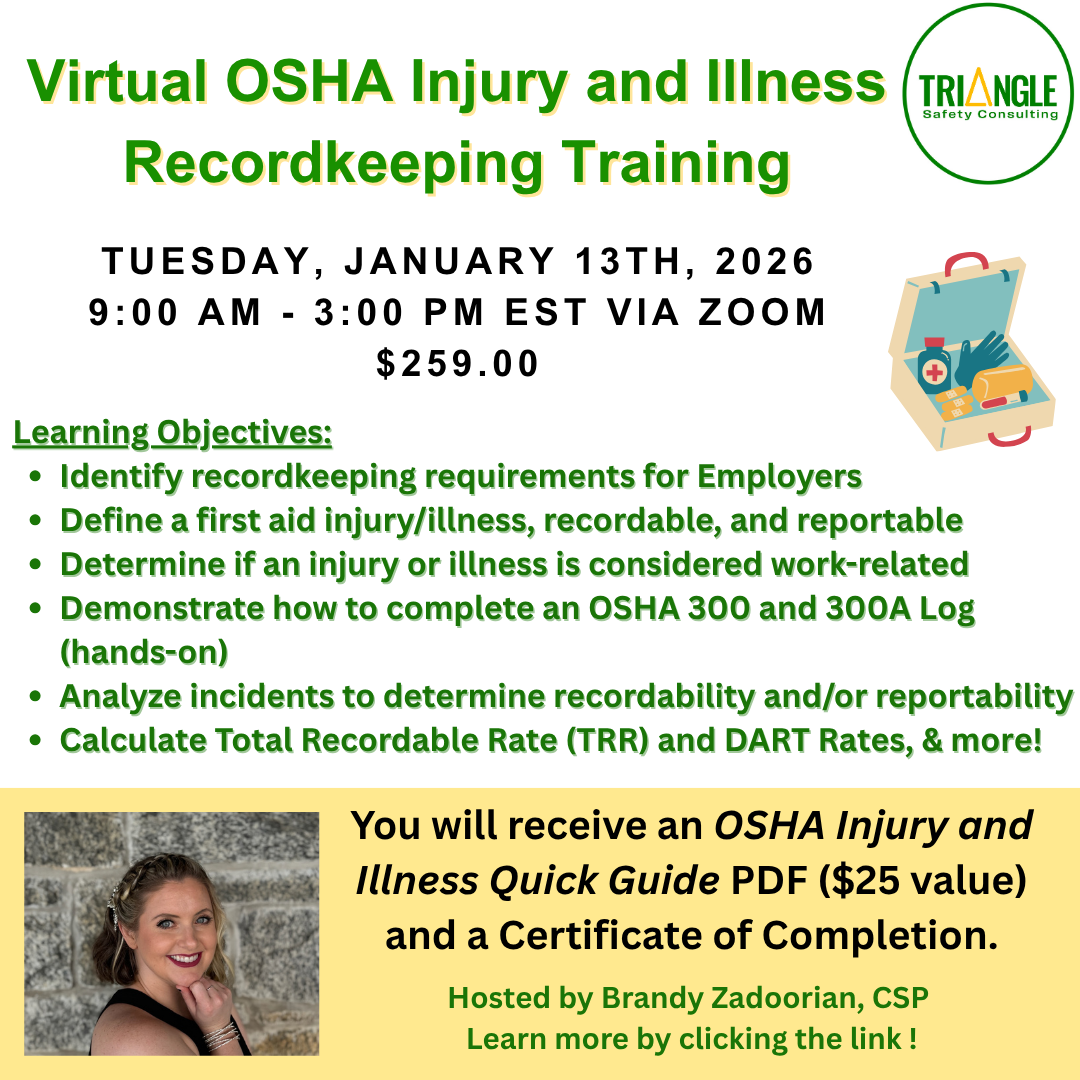

Let's do a mental health check!
Let's do a mental health check! Respond to the poll on how you are doing. HOW ARE YOU FEELING?
Eyewash Stations
We use Cintas at one of our facilities. We have 5 stations and they charge $188/unit for their service. It's outrageous. What would I have to do to take this in house? Can I just buy wall mounted units? How often would I have to change out the contents of the units?

Powered Floor Cranes attachment lift capacity
Recently, a team member decided to replace the attachment that came with one of our powered floor cranes because it was too short. They went and made one up themselves with nuts, bolts, and a chain. (See picture) I went and removed said attachment, stating it was not in accordance with the manufacturer's recommendations and had not been tested to have the crane's lifting capacity (2500 lbs.). The facility manager brought up a spec from Google regarding the bolt's shear rating, which was well above the crane's minimum capacity. This is the issue I have to deal with: telling team members this is wrong and not to do this, and managers saying, "Well, not really." Well, that is the start to my week. I hope everyone else has a better start to theirs.

Burden of Proof for not recording a fabricated injury
Hello Knights, I'm in a situation where an employee with a history of attendance issues, strange inquiries into available sick time, and the reported mechanism of injury that doesn't align with the injury that is claimed. Based on the above and other information specific to the case, there is evidence to support that the injury is fabricated. To be clear, I don't take it likely to not record an injury and this line of inquiry is not coming from management, I would like to know. The only information I've found about disputed cases is this LOI, which has been archived https://www.osha.gov/laws-regs/standardinterpretations/1993-06-21-3 Is it possible to provide enough documentation to support that this is not a work related injury? Is that even possible or are we up a creek?
Industrial Robotics Training for Engineers
We're evaluating the training we provide to engineers for Industrial Robotics. Hoping to gauge this community on how others approach this topic. For external training on this topic, does anyone have a recommended vendor and course? For internal training on this topic, what training do you provide engineers beyond the external training?

Exemption 1910.119 (a)(2)(iii) to OSHA's PSM of Highly Hazardous Chemicals
Hello Safety Knights! Calling all PSM experts! I am supporting a company that has a "process" which involves a chemical at or above the specified threshold quantities listed in appendix A. This particular "process" occurs at a remote site in Texas in which employees travel to only when very specific operations need to be executed. As of right now, no employee is permanently stationed at this Texas site full-time. The majority of the time, employees sit out of the company's HQ location in California. I am trying to assess if PSM exemption 1910.119 (a)(2)(iii) would apply in this scenario: "Normally unoccupied remote facilities." Any advice on how to interpret this exemption would be greatly appreciated. Thank you so much!
Grated Walkways in the Great White North
We're expanding a facility in Canada that has the potential to receive a large amount of snow and ice each year. The design has three levels of grated walkway and then a walkway underneath to service stacked equipment. Obviously I know we can shovel snow, use snow melt, and potentially some heated walkway pads, etc., but I thought it was worth asking if anyone has any experience with particular solutions that are effective at limiting snow/ice and falling ice hazards while minimizing manual labor. Or just any products that work well or products to avoid. Thanks!
Job Opportunities
Hi everyone! Would anyone know of any EHS Specialist or Coordinator job opportunities in the Houston area?
Open Hole Cover Protection Question
I have a protection question for a precast concrete lift station structure that is being installed on a worksite. The structure is 48" above grade and is about 16 feet deep. I am having trouble finding the requirement for covering the opening at the top of the structure. Is a cover required if the opening is above the 42" guardrail guideline? Thank you in advance for your guidance,

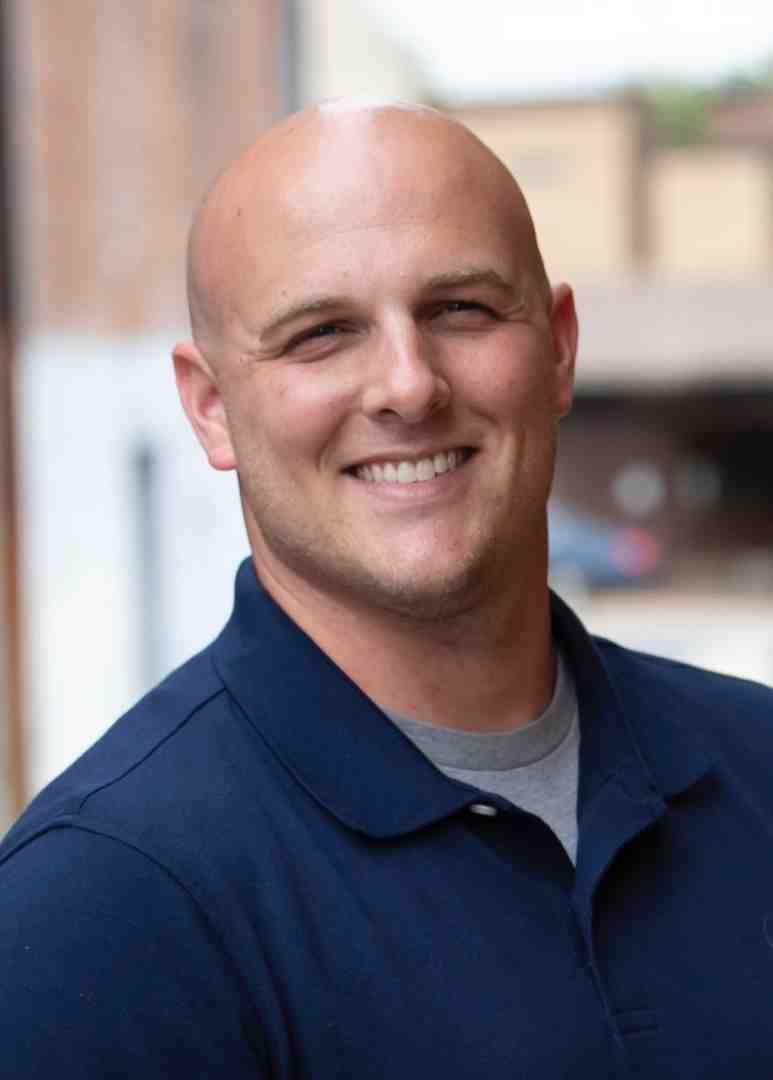
Fire Prevention Week - Disposing of Lithium Ion Batteries
Don’t toss lithium-ion batteries or devices in the trash or regular recycling bins. Instead, drop them off at a legit battery recycling spot. If the battery or electronic device that contains the battery is disposed of in the trash or placed in the municipal recycling bin with household recyclables such as plastic, paper or glass, it may become damaged or crushed in transport or from processing and sorting equipment, creating a fire hazard. Place each battery or device containing a battery in a separate plastic bag. Place non-conductive tape (e.g., electrical tape) over the battery’s terminals. Even used batteries can have enough energy to injure or start fires. Not all batteries are removable or serviceable by the user. Heed battery and product markings regarding safety and use. If the battery and/or device is damaged, package the battery or device in a non-flammable material, such as sand or kitty litter, as soon as possible, then contact the battery or device manufacturer for additional specific handling information. Visit call2recycle.org to find a drop-off location near you. Check back tomorrow for our final safety tip for Fire Prevention Week's "Charge into Fire Safety" campaign!


Fire Prevention Week - Safe Charging of Lithium-Ion Batteries
Charging something big like an e-bike, scooter, or power tool with a lithium-ion battery? Do it outside. Use a flat, dry area away from direct sunlight, anything wet, kids, or tripping hazards. And make sure your bike or device is secure so that it doesn’t fall while charging. Below are a few tips to help ensure you charge your lithium-ion batteires safely: • Never charge electronics on a bed, couch, or under a pillow. • Don't charge electronics overnight or all day to prevent overcharging. • Do not store batteries on their chargers. • Always use the original charger from the manufacturer or an approved, listed equivalent. • Be mindful of abnormal battery behavior – failure to fully charge or hold a charge, longer-than-usual charging times, noticeable drop in performance, unusual LED activity when placed on a charger (with batteries so equipped), liquid leakage from the battery, or melted plastic anywhere on the pack. These are indications of an internal problem. • Do not attempt to revive a battery that will not take a charge. Do not jumpstart, use other batteries, or use other power sources. Doing so may cause long-term battery damage that can result in burns, fire, or explosion. Check back tomorrow for more safety tips!
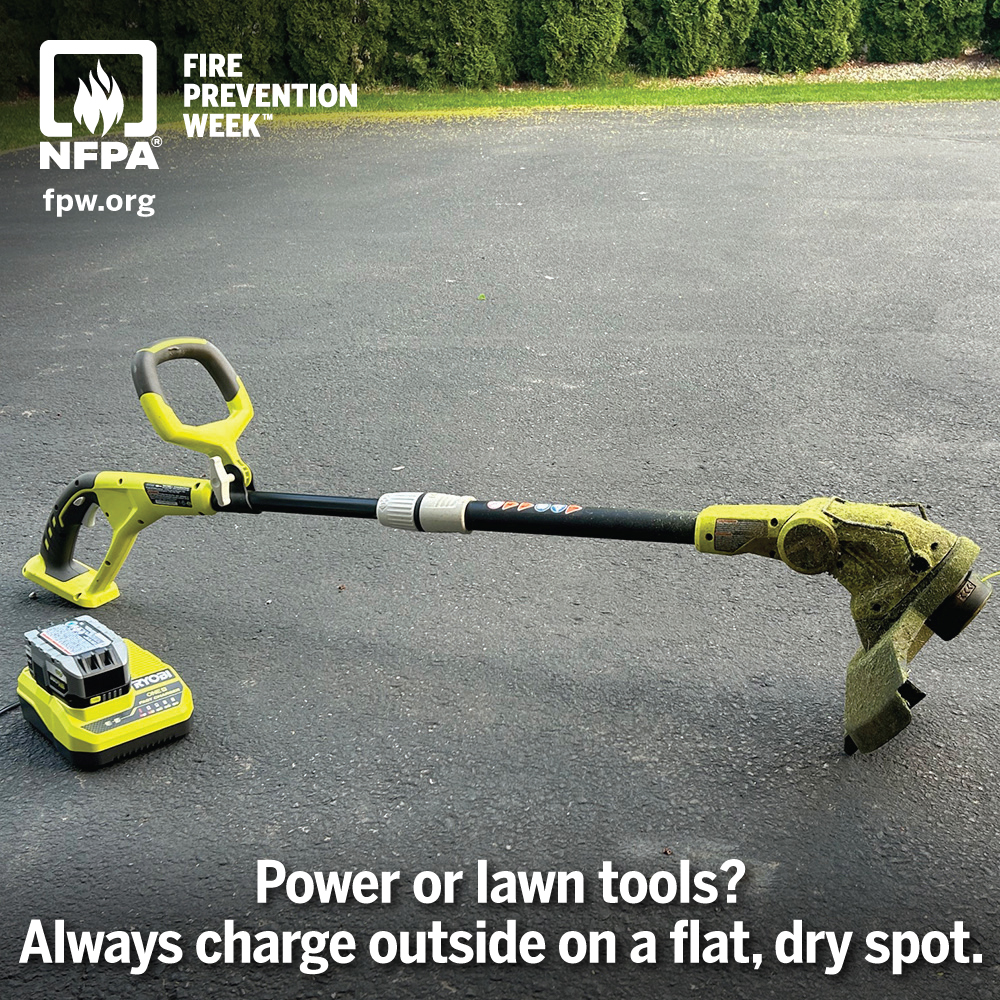

Fire Prevention Week Tips - EV Charging
Global sales of electric vehicles (EVs) exceeded 17 million in 2024 (a 25% increase from the previous year), according to the International Energy Agency. Sales are expected to grow significantly in the coming years. When the lithium-ion batteries used to power today’s EVs catch fire, they burn much differently than the gasoline and diesel used to power internal combustion engine (ICE) vehicles. Explore the following information and resources from NFPA to learn more about EV fires and how you can stay safer: • Never use extension cords with the EV charger. • Before charging an EV at home, have a qualified electrician check your home's electrical system to see if it can handle charging your EV, and install a new circuit just for your charging device. • Only have EV battery maintenance performed by the manufacturer, dealer, or another authorized and qualified person. • Only use charging devices that are listed by a qualified testing laboratory (e.g., UL, CSA). • Cover charging station outlets to keep water out. • Determine whether you will be performing Level 1 or Level 2 charging (Level 2 uses a 240-volt outlet). • Always follow all manufacturer directions. • Never touch the orange high-voltage (HV) cables. The HV battery is typically 400 volts or 800 volts. Did you know that the National Fire Protection Association (NFPA) offers a free EV Community Preparedness Online Training for the public? Register for that training here: https://shorturl.at/OnXj8 For first responders, NFPA also provides training on responding to incidents involving alternative fuel vehicles, including EVs. Explore all NFPA EV training by clicking here: https://shorturl.at/i203j Check back tomorrow for more safety tips!
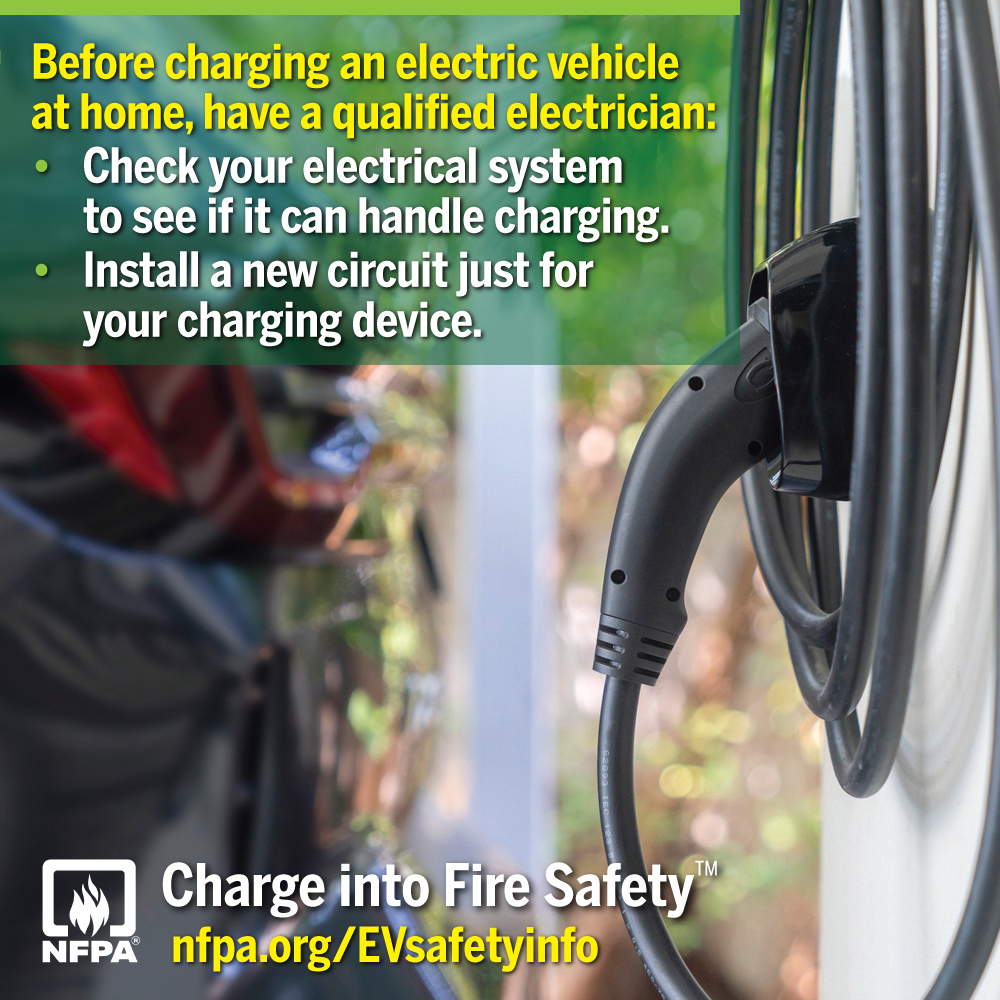

Fire Prevention Week
This year’s Fire Prevention Week™ (FPW™) campaign, October 5-11, “𝐂𝐡𝐚𝐫𝐠𝐞 𝐢𝐧𝐭𝐨 𝐅𝐢𝐫𝐞 𝐒𝐚𝐟𝐞𝐭𝐲™: 𝐋𝐢𝐭𝐡𝐢𝐮𝐦-𝐈𝐨𝐧 𝐁𝐚𝐭𝐭𝐞𝐫𝐢𝐞𝐬 𝐢𝐧 𝐘𝐨𝐮𝐫 𝐇𝐨𝐦𝐞,” works to educate everyone about using these batteries safely. The campaign stresses how important it is to BUY, CHARGE, and RECYCLE safely when it comes to lithium-ion (Li-ion) batteries. Lithium-Ion batteries are found in many common products, including, but not limited to: • Cell Phones, Tablets, and Laptops; • Game Controllers; • Smoke/Fire/CO Detectors; • Handheld Power Tools (e.g., drills, saws, leaf blowers); • E-Bikes and E-Scooters; • Electrical Vehicles; • eReaders (e.g., Amazon Kindle, Barnes and Noble Nook); • Bluetooth Headsets and Headphones; and • Smartwatches Below are some tips to help you use lithium-ion batteries safely and prevent fires at home, in the workplace, or anywhere else they may be stored and/or used: • 𝐁𝐮𝐲 𝐨𝐧𝐥𝐲 𝐥𝐢𝐬𝐭𝐞𝐝 𝐩𝐫𝐨𝐝𝐮𝐜𝐭𝐬. When buying a product that uses a lithium-ion battery, look for a safety certification mark, such as UL (Underwriters Laboratory), ETL (Electrical Testing Laboratories), or CSA (Canadian Standards Association). This means it meets important safety standards. • 𝐂𝐡𝐚𝐫𝐠𝐞 𝐝𝐞𝐯𝐢𝐜𝐞𝐬 𝐬𝐚𝐟𝐞𝐥𝐲. Always use the cords that came with the product to charge. Follow the instructions from the manufacturer. Buy new chargers from the manufacturer or one that the manufacturer has approved. Charge your device on a hard surface. Don’t overcharge your device. Unplug it or remove the battery when it’s fully charged. • 𝐑𝐞𝐜𝐲𝐜𝐥𝐞 𝐛𝐚𝐭𝐭𝐞𝐫𝐢𝐞𝐬 𝐫𝐞𝐬𝐩𝐨𝐧𝐬𝐢𝐛𝐥𝐲. Don’t throw lithium-ion batteries in the trash or regular recycling bins because they could start a fire. Recycle your device or battery at a safe battery recycling location. Visit call2recycle.org to find a recycling spot near you. Check back tomorrow for more safety tips!


Intro to Forensic Interviewing
There is still time to signup for our next webinar; it is a great opportunity to learn more about a topic that is critical to deep diving in investigations, whether you are an EH&S professional, HR, or operations; learn the key elements to asking “guilt seeking questions”, overcoming denials, the legal landscape, as well as how to discuss sensitive topics! This is a great intro course, for those who lead investigations, and/or support them! You can sign up here! https://www.kaddyohs.com/event-list Kaddy OHS www.KaddyOHS.com 717-219-7043 Contact@kaddyohs.com https://www.kaddyohs.com/event-details/intro-to-forensic-interviewing-in-the-workplace
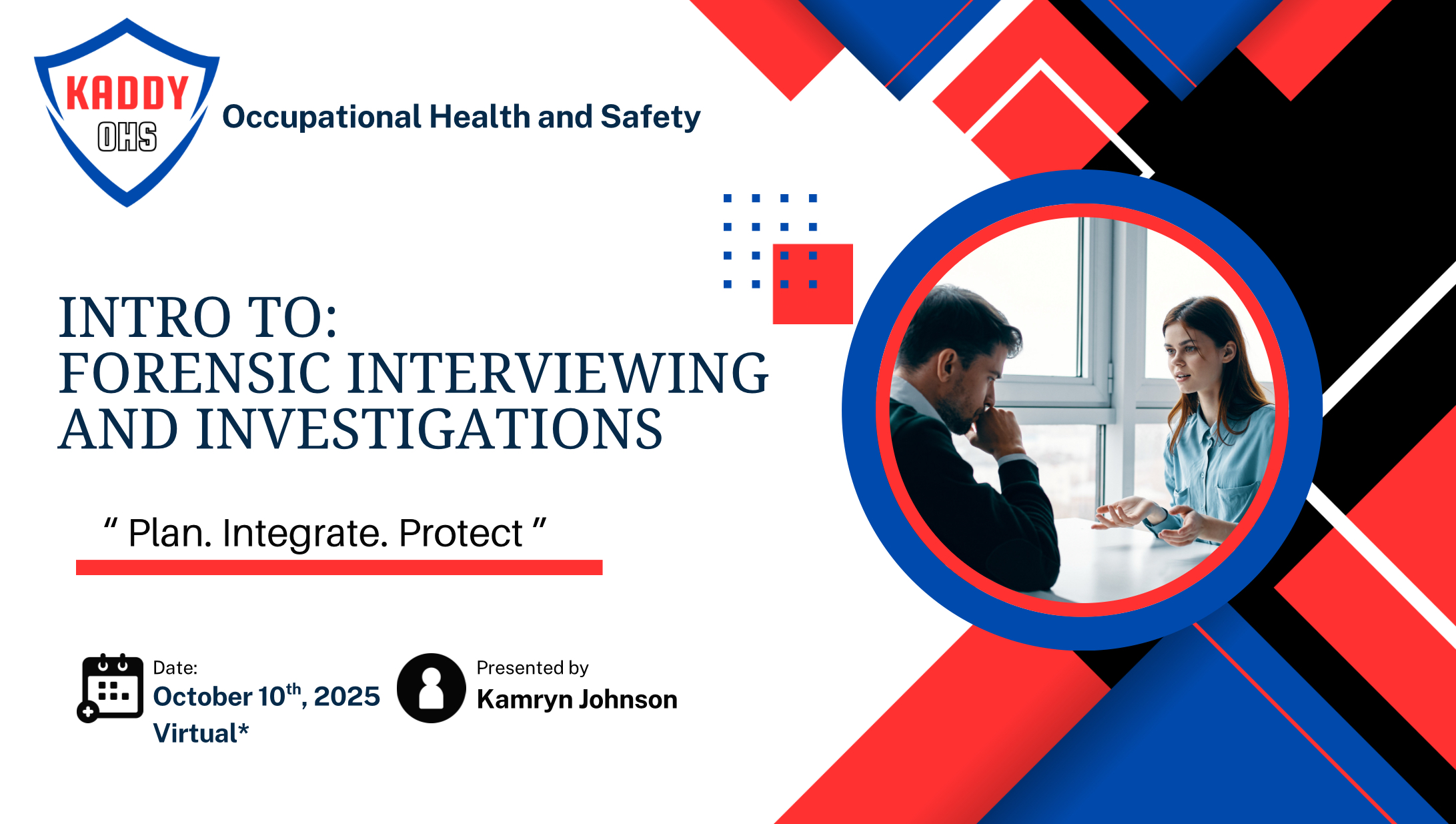

Excavation Access/Egress
I have a question that I am sure is a common sense answer but I can't seem to find any supporting information: If an excavation is wider than 50', how is the requirement of 25' travel distance to access/egress applied? Does it just become a lateral distance along the excavation walls?
